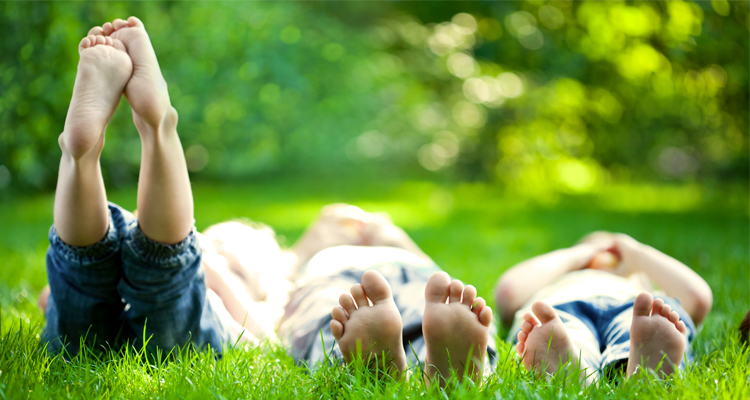Soft grass on your feet, sand in your toes, warm pavement, splashing in puddles—the feeling of going barefoot creates sensory memories that many of us associate with summer and happy days.
With 25 percent of your body’s bones residing in your feet, careful attention must be paid to taking proper care of them, especially when it comes to children with ever-growing and developing bodies. Many kids enjoy the freedom and fun of going barefoot in the summer, so parents must consider the benefits and cautions of allowing their little ones to play in bare feet.
Exposure to Elements
In extreme temperatures, unprotected feet run the risk of getting burned or frost-bitten. In addition to climatic concerns, barefoot children can be exposed to sharp objects on the ground such as rocks, glass, metal, or anything else precariously waiting in their path.
On the other hand, though, many believe that this raw exposure is a vital sensory enhancement to proprioception. The Encyclopædia Britannica explains proprioception as “the perception by an animal of stimuli relating to its own position, posture, equilibrium, or internal condition.” What this means for children exploring their worlds while barefoot is that their bodies are able to have a heightened sense of awareness, including increased abilities to react appropriately to these environmental hazards.
[embedvideo id=”dP94CPkCmVU” website=”youtube”]
Shedding the Shoes
As so clearly evidenced in this scene from The Croods, shoes definitely have their time and place. Some of us even have a love for, or border-line obsession with, shoes: kids included. Shoes definitely have added value in correcting certain foot conditions or disorders and in enhancing athletic and sports performance.
However, if a shoe is not fitted properly for the individual child, it may serve to damage and hinder proper foot growth and development. Wearing the wrong type of shoe may even delay a child’s ability to walk and distort their senses of balance and proper posture, leaving bare feet as the better alternative. In fact, the notable London-based podiatrist Tracy Byrne stated, “Most children’s shoes ought to come with a government health warning.”
Knowing some shoes may be doing more harm than good, how confident are you now in your kids’ favorite cute light-up tennis shoes?
Health Hazards
Walking around multiple locations while shoeless may have the potential to expose your child to some not-so-pleasant foot infections. Although not as much a concern in the United States anymore, hookworm can be contracted through bare feet coming into contact with infected feces. Plantar warts can be caused by exposure to infected surfaces, oftentimes in shared showers or locker rooms. There is obviously a “yuck” factor when you think about your kids going barefoot in public bathrooms or any place leaving them with black-bottom feet.
To argue in support of bare feet, there are also many infections, such as athlete’s foot and toe fungus, which are caused by wearing shoes. Once a foot sweats or gets wet from the rain or walking through a puddle, shoes have the possibility of becoming breeding grounds for such infections.
Going barefoot has also been proven to avoid common injuries such as plantar fasciitis, tendonitis, shin splints, and bursitis. By strengthening the muscles in the foot through exercises and bare feet, the muscles in that area of your child’s body are better equipped to handle the stresses and strains your children dish out on a daily basis.
In weighing all the arguments both for and against setting your kids feet free this summer, it seems as if allowing your children to play barefoot is not only a way to enhance their sensory experiences but also may prove helpful to their strength and development. Simply use caution and reasonable judgment, as is the case with most parenting decisions, and always supervise their outdoor barefoot exploration.
What are your opinions? Did you go barefoot everywhere as a child? Do you let your children do the same? Share your thoughts with us below.




































